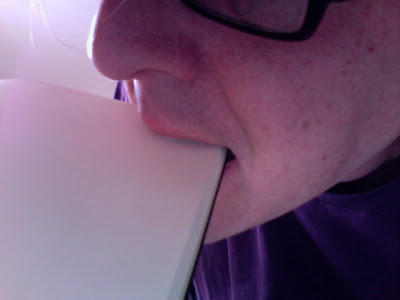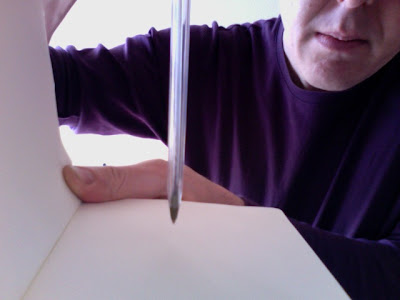

The Strawberry Jam Critic demonstrating two different art-writing methodologies, London, February 2009 ( posed by model).
1.
Because The Strawberry Jam Critic was trying to get a sense of the full extent of the critical task. It wasn't about Bethnal Green alone. It was about Aldgate East, Whitechapel, Bethnal Green, and Mile End. Cinemas all, but what kind? Sometimes, too, it was about double-screen Leyton, a Gore Vidal let loose on the full extent of the 25 bus route.
The gossip, they say, always funny, often salacious, is inseparable from the critical judgement. Treat subjects intimately, as colleagues in the business, mocking their vanities and weaknesses. Be quick to spot a nail where a screw should be...
2.
At every full stop: Strawberry Jam critics jostling to get on and off. In every spoonful of jam, prose.
Or was it proselytizing? Writing is different from life and doesn't have to be real fruit or organic. It's probably better if it's not, whereas with jam that is never prose the need for additive-free is clearer.
Even so, having to construct ones own cinema building from scratch every day, ready for the evening shows, children's matinee on the weekend, was intellectually exhausting.
3.
There was an academic frame that had hovered over all the Strawberry Jam Critic's pronouncements and SJC wanted to keep the best of this - the seeking to understand through dialogues of context, history, and discernment.
But SJC wanted to remove the way such a frame manifested in prose as power and authority, as the limit of cultural ambition, the curtailment of expressive freedom, and the lack of amusing punctuation. SJC wanted dust.
Dust, Strawberry Jam Critic liked to mumble to themselves. Dust for its avoidance of incomprehension leading to nonsense. Dust of obscure hierarchies and vegetables no one knew how to eat. Dust of nonsense itself could be comprehended by avoidance. Dust. Although -
4.
Strawberry Jam Critic needed to maintain some sense of discipline to avoid becoming a pure babble of street sound. The police called to ask if there were still social order problems in the street. Maybe, thought Strawberry Jam Critic, maintain the academic framework by metamorphosing into a small pile of boiled sweets filling up the corner of the room.


The Strawberry Jam Critic turning into pure light, London, Feb 2009 (posed by model).
5.
Because, too, it was the range of the culture and forms of expression that all SJC's writings were beginning to articulate. Strawberry Jam Critic felt it was a big step to write about things as if they were interesting. Especially boring things.
Not that the interesting things weren't interesting, of course, but interesting wasn't the right word. It was a shift to try and write out of the vibrancy of something's cultural presence, their event-ness, so that it became gossip, always funny, often salacious.
Such an attitude, like the Strawberry Jam Critic himself, was constructively - if not unpleasurably - deluded.
6.
Perhaps it also involved inhabiting the gap between the artists intention - how it was presented in press releases, handouts, wall texts - and the experience. It might mean disregarding the former, going with the whim, seeing creativity in the interstice, wearing more than one pair of trousers.
This was why Strawberry Jam Critic had turned, not without some reservation, to New Journalism and Clay Felker as models, rather than Ancient Egypt. Tom Wolfe's Radical Chic, of course - like a lot of his writing - was in many ways a spiteful, nasty piece of character assassination, from which - her children have observed - Leonard's Bernstein's wife never recovered.
But Strawberry Jam Critic is ensnared by its energy, its perceptiveness and its sense, above all, of writing and culture interlocked in a certain vibrancy. If the culture is not vibrant and the writing is garbage then I don't know what happens.
Pass the strawberry jam somebody please.
7.
There is a key text for The Strawberry Jam Critic. The Strawberry Jam Critic reads this text daily, and had it tattoed on their back by the finest calligrapher on all of Commercial Street.
This text is from near the beginning of Adolfo Bioy Cesares' The Invention of Morel:
An Italian rugseller in Calcutta told me about this place. He said (in his own language): "There is only one possible place for a fugitive like you - it is an uninhabited island, but a human being cannot live there. Around 1924 a group of white men built a museum, a chapel, and a swimming pool on the island. The work was completed, and then abandoned.
I interrupted him; I wanted to know how to reach it; the rug merchant went on talking: "Chinese pirates do not go there, and the white ship of the Rockefeller Institute never calls at the island, because it is known to be the focal point of a mysterious disease, a fatal disease that attacks the outside of the body and then works inward. The nails drop off the fingers and toes; the hair falls out. The skin and the corneas of the eyes die, and the body lives on for one week, or two at the most. The crew of a ship that had stopped there were skinless, hairless, without nails on their fingers or toes - all dead, of course - when they were found by the Japanese cruiser Namura. The horrified Japanese sank their ship."
But my life was so unbearable that I decided to go there anyway. The Italian tried to dissuade me; but in the end I managed to obtain his help.(10)


The Strawberry Jam Critic demonstrating the similarities and differences of writing and reading, London, Feb 2009 (posed by model).
8.
Oh strawberry jam, strawberry jam, strawberry jam, strawberry jam, strawberry jam. Oh more jam of the strawberry variety with extra strawberry oh oh indeed. I have read other novels recently, too, amidst my very personal excess of cinemas.
It's true what bloggers say: like the love child of D.W.Griffith and Andy Warhol I play on this mix of isolation, wonder, and something grimmer, fishing X out of the jam-bog with nothing but a sharp enough strawberry-witticism.
Note, too, in conclusion, that within a paragraph Cesares is asleep on his island of death, and is noting how, when it comes to combinations of writing and film:
And yet suddenly, unaccountably, on this oppressive summerlike night, the grassy hillside has become crowded with people who dance, stroll up and down, and swim in the pool, as if this were a summer resort like Los Teques or Marienbad. (10-11)
SOURCES
The origins of The Strawberry Jam Critic were at Jennifer West's show at Vilma Gold last year, after-pondering the relevance of her method of making films through the application of various smeared and treated substances.
The second paragraph beginning "The gossip.." is derived from Jonathan Raban's review of The Selected Essays of Gore Vidal (New York Review of Books, Dec 18-Jan 14 2009, 67). New York Review books publish Ruth L.C.Simms translation of Adolfo Bioy Casares The Invention of Morel ISBN 978-1-59017-057-1.
The phrase "other novels recently, too, that play on this mix of isolation, wonder, and something grimmer" is a reference to Stanley Crawfords splendid The Log of The SS Ugentine, recently reissued by Dalkey Archive Press.